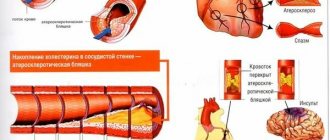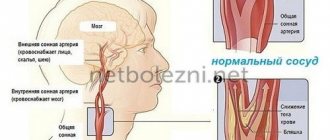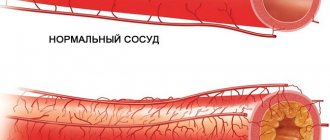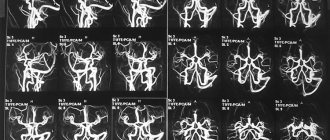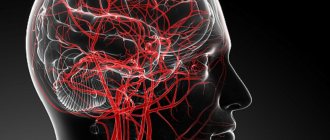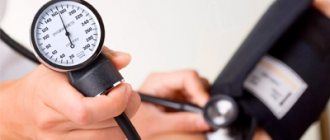One of the first places in the world is occupied by mortality from cardiovascular diseases. Vascular diseases, blockage of arteries and veins negatively affect the functioning of all organs of the body.
Arteries are blood vessels that carry oxygenated blood throughout the body. With the bloodstream, the necessary vitamins, hormones, and nutrients are carried to every part of the human body. Healthy blood vessels have smooth inner walls, and blood flows smoothly through them.
What is vascular blockage?
Blockage of blood vessels occurs due to various factors:
- thrombosis;
- injuries;
- the appearance of atherosclerotic plaques on the walls.
A thrombus is a blood clot that forms as a result of damage to the inner wall of an artery. The plaque is formed from substances circulating in the blood: calcium, cholesterol, fibrin. The body evaluates this formation as a defect and the process of thrombus formation begins. Unlike arterial thrombosis, venous thrombosis is not characterized by cholesterol deposition.
As deposits build up in the arteries, a condition called atherosclerosis occurs. This condition leads to narrowing and hardening of blood vessels.
Risk factors contributing to vascular blockage:
- increased cholesterol levels;
- high blood pressure;
- diabetes;
- smoking;
- obesity;
- sedentary lifestyle;
- genetic predisposition.
Symptoms of vascular blockage
Often, poor arterial patency does not cause any pain until a serious complication such as a stroke develops.
In other cases, especially when more than half of the artery is blocked, symptoms such as:
- discomfort, chest pain;
- severe shortness of breath;
- rapid heartbeat;
- dizziness;
- nausea;
- weakness;
- sweating
Due to a decrease in blood flow to the heart, chest pain (angina) appears, then coronary heart disease develops.
Peripheral artery blockage can cause:
- Leg pain.
- Poor healing of foot injuries.
- Gangrene.
If there is obstruction of the cerebral vessels, a person experiences headaches, constant or periodic, increased blood pressure, dizziness, vomiting, and unclear consciousness.
Consequences of the disease
Depending on the location of the damaged vessel, various complications arise. With obstruction in the extremities, nagging pain in the legs first appears, then trophic ulcers and tissue necrosis. Amputation is indicated, otherwise gangrene may develop. With prolonged ischemia of the heart vessels, myocardial infarction occurs. Long-term obstruction of blood vessels in the brain causes a stroke.
Causes of atherosclerosis of the vessels of the lower extremities
Atherosclerosis of the vessels of the lower extremities
There is a complex of factors that contribute to
atherosclerotic vascular damage , including the arteries of the lower extremities. There are non-modifiable (that is, unchangeable) and modifiable (modifiable) risk factors. Non-modifiable risk factors include:
- age (the older you are, the stronger the manifestation of atherosclerosis);
- gender (men suffer from atherosclerosis much more often than women);
- genetic predisposition (if there are strokes and cardiovascular diseases in the family history, atherosclerosis is more likely).
Main modifiable risk factors
:
- disorders of lipid metabolism (increased levels of total cholesterol in the blood. A distinction is made between low-density lipoprotein cholesterol and high-density lipoprotein cholesterol. The threat of atherosclerosis increases with an increased content of low-density lipoprotein cholesterol and, conversely, with a reduced content of high-density lipoprotein cholesterol.);
- smoking;
- diabetes;
- obesity, overweight;
- high blood pressure (accelerates the development of atherosclerosis);
- sedentary lifestyle (leads to metabolic disorders);
- poor nutrition;
- renal failure.
For the development of atherosclerosis of the arteries of the lower extremities, smoking and diabetes mellitus are of greatest importance.
Diagnostics
If poor patency of arteries and veins is suspected, the following studies are performed:
- Cholesterol analysis.
- Chest X-ray.
- CT scan.
- Ultrasound.
- Echocardiogram.
- ECG.
- MRI scan.
- Angiogram.
Magnetic resonance imaging (MRI) uses magnets and radio waves to produce images inside the body without a surgical incision. Unlike CT scans, MRIs do not use ionizing radiation. This is considered a safer alternative.
Risk factors for OASNK
Atherosclerosis of the vessels of the lower extremities is characterized by the same risk factors as other arterial diseases, for example: coronary heart disease and cerebrovascular insufficiency.
- High blood pressure (hypertension),
- High blood cholesterol levels,
- Smoking,
- Sedentary lifestyle,
- Obesity,
- Burdened heredity.
A few words about smoking. Complete abstinence from any form of tobacco is necessary. Smoking even 1 cigarette per day of the lightest type is an unfavorable risk factor that causes the progression of obliterating atherosclerosis of the lower extremities and the development of its severe complications. The nicotine contained in tobacco causes the arteries to spasm, thereby preventing blood from moving through the vessels and increasing the risk of blood clots in them.
Treatment of vascular blockages
There are many options for preventing and treating blood clots. Depending on the severity of the condition and the patient's medical history, the doctor prescribes various methods.
Disease prevention:
Quitting bad habits, urgent lifestyle changes:
- a diet low in saturated fat and cholesterol, less sugar and simple carbohydrates, and high in fruits and vegetables;
- body weight loss;
- ban on smoking and alcohol;
- fitness classes;
- minimizing stress;
- lowering blood pressure and cholesterol using folk remedies;
- maintaining low blood sugar levels by avoiding large amounts of sweets, jam, and sweets.
Drug treatment
Some medications help prevent clogged arteries, such as:
- cholesterol-lowering medications;
- drugs that lower blood pressure;
- blood thinners, which reduce the chance of dangerous blood clots.
Surgical intervention.
In the later stages of the disease, drug measures do not help improve the situation and then surgical procedures are used:
Stenting
A small tube called a stent is placed in the artery to maintain good blood flow. A catheter is inserted through an artery in the leg to reach the heart, and a stent is inserted through the catheter into the area of the blockage.
Coronary artery bypass grafting
In this surgery, arteries from other parts of the body are moved to the site of blocked arteries to help the blood reach its target destination.
Balloon angioplasty
A device is used that pushes the plaque towards the side walls of the arteries, resulting in the opening of the vessel lumen.
But in advanced cases, especially when the vessels of the legs are damaged, it is not possible to save the limbs, amputation is indicated.
Treatment
It is better to treat ailments that are associated with blockage of blood vessels in the early stages. When the vascular lumen is still slightly blocked, drug therapy in combination with the correction of factors that cause the growth of cholesterol plaques will help stop the development of atherosclerosis. Remember that successful treatment of atherosclerosis is only possible against the background of complete smoking cessation and diet. If medication is ineffective and there is a direct threat of dangerous complications, vascular surgeons come to the rescue.
If surgical treatment is necessary, there is not always a need for open operations: bypass surgery, endarectomy, etc. Today, endovascular surgery techniques are widely used in the treatment of vascular diseases. In this case, the effect on the vessel occurs using minimally invasive methods, and the operations themselves are painless and do not require long-term recovery. When blood vessels are blocked, angioplasty and stenting are performed. Using these procedures, reconstruction of a blocked vessel is carried out in just 1-1.5 hours with a minimum patient stay in the hospital.
How to clean blood vessels effectively with folk remedies - recipes and prevention
Today there are a lot of recommendations on how to clean blood vessels using folk remedies and methods of official medicine. Of course, in the case when the disease is advanced and is in an acute phase, no folk or home methods will help and you should immediately consult a doctor.
But as a preventative measure, restoring the condition of blood vessels and preventing the development of pathologies, you can follow tips on how to clean blood vessels with folk remedies at home.
Subscribe to our VIBER channel!
- First of all, you should change your diet and reduce as much as possible the amount of fatty foods and dishes that increase blood cholesterol levels.
- The amount of salt, sugar, spicy and smoked foods consumed is also reduced.
- Increase the consumption of fresh vegetables and fruits, cereals, thanks to which blood vessels are cleansed, toxins and wastes are removed from the body, the level of immunity and protection increases, and any organ is cleansed.
If you are overweight, this pathology also negatively affects the condition of blood vessels. Contact a professional nutritionist who will develop an individual diet for you, thanks to which you will improve your well-being, get rid of extra pounds, and restore the elasticity of your blood vessels.
How to effectively clean blood vessels using folk remedies: examples of recipes:
- Using garlic. This vegetable is a very effective aid in cleaning blood vessels. You need to take about 150 g of peeled garlic, chop it and pour alcohol or vodka (150 ml). Place this composition in a glass container, close it tightly and leave in a dark place for 10 days. After this period ends, strain the composition through cheesecloth and store your folk remedy in the refrigerator. You should take 20 drops of the infusion, diluted in half a glass of water 20 minutes before meals, three times a day. The course of treatment is 1 month.
- Rosehip is also effective in combating blockage of blood vessels. It is enough to pour 2 tablespoons of boiling water. dried rose hips, leave for 6 hours in a thermos and drink this drink 1 liter per day for 1 month.
- Walnuts and tincture of this healthy product help cleanse blood vessels and strengthen their walls. For the tincture, take 1 glass of walnut partitions, pour a glass of vodka over them and infuse the composition for 2 weeks in a dark place. Three times a day for 2 weeks, dilute 50 ml of water with 20 drops of tincture and consume, regardless of meals.
- To help you figure out how to quickly and effectively clean blood vessels with folk remedies, a healing composition will help you: orange, lemon and honey. You need to take 2 pieces of citrus fruits, peel them and cut them into small pieces and grind them using a blender. Add 2 tbsp to the mixture. honey, mix everything thoroughly, place in a glass container and close tightly with a lid. Place the jar in the refrigerator and after a day you can consume 1 tbsp. composition, 3 times a day before meals.
- Another tasty and healthy recipe helps. You will need lemon juice, olive oil and honey. Take all ingredients in equal proportions, mix well and take 1 tsp in the morning on an empty stomach.
- Fresh juices are no less effective in cleaning blood vessels: celery, carrots, tomato and pomegranate juice.
Along with healthy foods and recipes of traditional and official medicine, you should lead an active lifestyle, take long walks, play sports and exercise moderately . Thanks to such actions, you will restore blood flow, which will prevent the accumulation of bad cholesterol, the appearance of excess weight, and will help maintain your cardiovascular system in a healthy state for a long time. Published by econet.ru.
Ask a question about the topic of the article here
PS And remember, just by changing your consumption, we are changing the world together! © econet
Symptoms of vascular occlusion
Acute occlusion of the vessels of the extremities is manifested by a symptom complex, designated in the English literature as the “complex of five Ps” (pain - pain, pulselessness - lack of pulse, pallor - pallor, paresthesia - paresthesia, paralysis - paralysis). The presence of at least one of these signs makes one think about possible acute occlusion of the vessels of the extremities.
Sudden pain distal to the site of occlusion occurs in 75-80% of cases and is usually the first sign of acute occlusion of the vessels of the extremities. If collateral circulation is preserved, pain may be minimal or absent. More often, the pain is diffuse in nature with a tendency to intensify, and does not subside when the position of the limb changes; In rare cases of spontaneous resolution of occlusion, the pain disappears on its own.
An important diagnostic sign of acute occlusion of the vessels of the extremities is the absence of pulsation of the arteries distal to the site of occlusion. In this case, the limb first turns pale, then acquires a cyanotic tint with a marbled pattern. Skin temperature is sharply reduced - the limb is cold to the touch. Sometimes, upon examination, signs of chronic ischemia are revealed - wrinkled and dry skin, lack of hair, brittle nails.
Disorders of sensitivity and motor sphere in acute occlusion of the vessels of the extremities are manifested by numbness, tingling and crawling sensations, decreased tactile sensitivity (paresthesia), decreased muscle strength (paresis) or lack of active movements (paralysis) first in the distal and then in the proximal joints . In the future, complete immobility of the affected limb may occur, which indicates deep ischemia and is a formidable prognostic sign. The end result of acute vascular occlusion can be gangrene of the limb.




